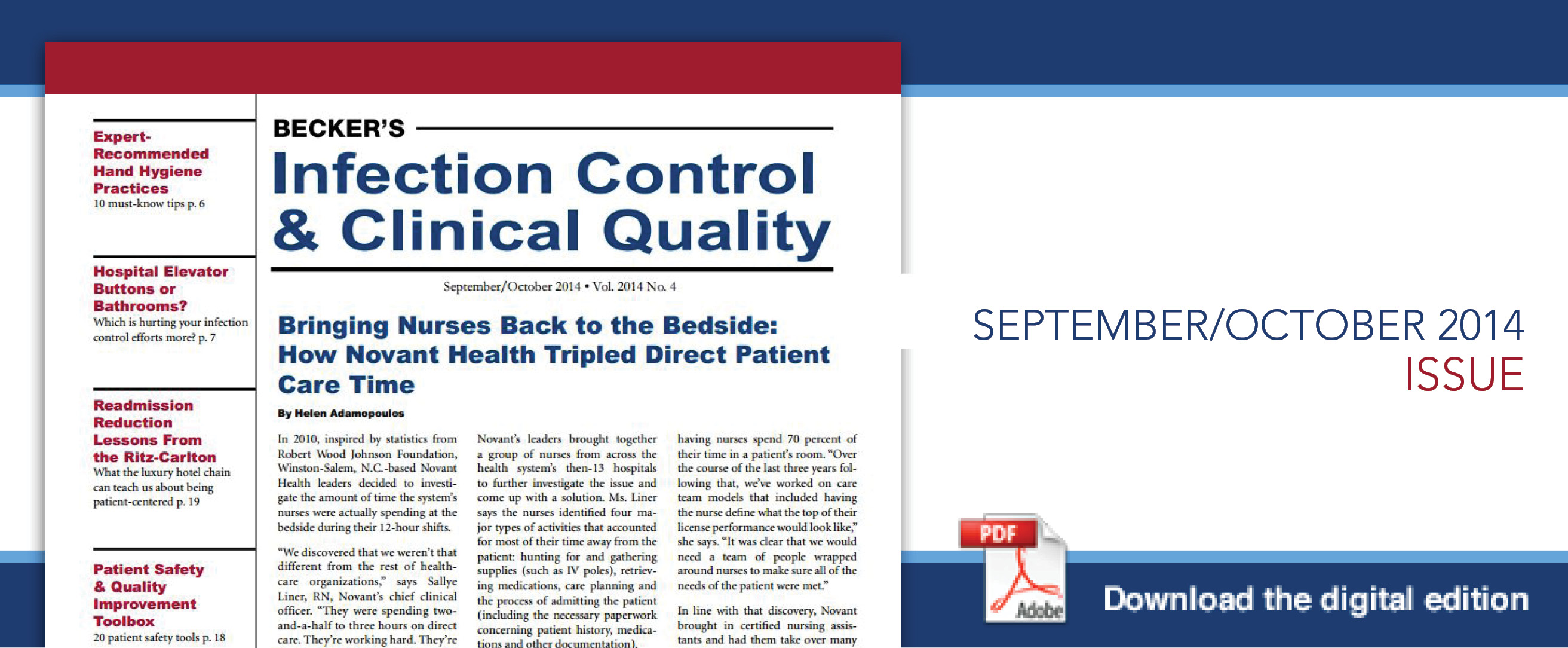On the Cover
|
|
Bringing Nurses Back to the Bedside: How Novant Health Tripled Direct Patient Care Time |
|
|
Are You Misuing the Term ‘Population Health?’ |
 |
Inside the One C. Diff Vaccine Focusing on Prevention, Not Treatment |
Preventing HAIs
10 Expert-Recommended Hand Hygiene Practices
Newly released expert guidance on hand hygiene in healthcare facilities, published in Infection Control and Hospital Epidemiology, emphasizes best practices for implementing and optimizing hand hygiene programs to reduce the spread of healthcare-associated infections. Click here to continue>>
MRSA-Fighting Drug Approved by FDA
The FDA has approved Cubist Pharmaceuticals' new drug, Sivextro, for the treatment of acute bacterial skin infections, including those caused by methicillin-resistant Staphylococcus aureus.Click here to continue>>
Updated Guidelines for Skin, Soft Tissue Infections
The spread of methicillin resistant Staphylococcus aureus has led to a giant increase in the number of skin and soft tissue infections, according to the Infectious Diseases Society of America. Click here to continue>>
Clinical App Provides Antimicrobial Usage Guidelines at Point of Care
A new app released by the University of Nebraska Medical Center is addressing antimicrobial resistance by providing point of care access to antimicrobial usage guidelines. Click here to continue>>
Hospital Elevator Buttons More Germy Than Bathrooms
Hospital elevator buttons are commonly colonized by bacteria, and have a higher prevalence of colonization than bathroom surfaces, according to research published in Open Medicine. Click here to continue>>
Executive Briefing: Infection Prevention
How one facility improved hand hygiene compliance 50%
The following content is sponsored by PDI. According to the U.S. Centers for Disease Control and Prevention, it is estimated that one in every 25 hospitalized patients will contract a healthcare-associated infection. Click here to continue>>
36 Approaches to Reducing 9 Common Medical Errors
After Partnership for Patients released a report earlier this year detailing the nine most common medical errors in the United States, Sen. Barbara Boxer (D-Calif.) sent a letter to 283 acute-care hospitals in California asking them to detail the actions they are taking to reduce medical errors. Click here to continue>>
Executive Briefing: Eradicating HAIs
A New Soldier in the War Against HAIs: UV Robots
About one in 20 hospitalized patients in the United States experience a healthcare-associated infection, and many of them don't survive: An estimated 75,000 hospital patients with HAIs died during their hospitalization in 2011, according to the Centers for Disease Control and Prevention. Click here to continue>>
13 Most Common Healthcare-Associated Infections
Healthcare-associated infections are a consistent issue for both hospital patients and healthcare providers. Click here to continue>>
Patient Safety & Quality Improvement Toolbox
20 patient safety tools
To supplement the material and analysis provided by Becker's Clinical Quality and Infection Control, Becker's Healthcare offers an online database of free and low-cost downloadable patient safety tools and resources, putting them all in one place for user convenience. Click here to continue>>
Why One Hospital Thanks the Ritz-Carlton for Low Readmission Rates
Thirty-day readmission rates for hip and knee replacements at Indiana University Health Saxony Hospital are at 0.74 percent, more than seven times lower than the national average. Click here to continue>>
Study: 40% of Critical Information Omitted During Morning Handovers
Thorough communication appears to be lacking during morning handovers, according to a study in JAMA Internal Medicine. Click here to continue>>
Which Cities Have the Highest Hospital Readmission Rates?
Medicare's penalty program for excess hospital readmissions is among its most tenacious efforts to increase quality of care. Click here to continue>




